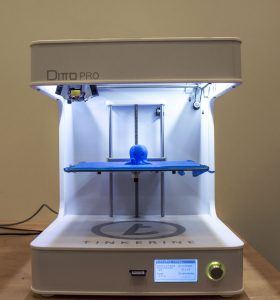Written by: Chantal Petgrave, 3D Printing peer tutor, Humanities & Social Sciences Library (BA, Industrial Relations, class of 2018)
 Have you ever been sitting in Research Commons Room B and heard a mechanical tittering sound, only to look up and wonder what it was? You may have noticed 3 machines in the back corner, and immediately decided that they were complicated contraptions that only McGill engineering students used. Fortunately, you were wrong — these complicated contraptions are actually 3D printers that are relatively easy to use. So easy to use, I can actually explain it in a blog post…
Have you ever been sitting in Research Commons Room B and heard a mechanical tittering sound, only to look up and wonder what it was? You may have noticed 3 machines in the back corner, and immediately decided that they were complicated contraptions that only McGill engineering students used. Fortunately, you were wrong — these complicated contraptions are actually 3D printers that are relatively easy to use. So easy to use, I can actually explain it in a blog post…
Let’s break down the process of 3D printing by first defining what it actually is: 3D printing is an additive manufacturing process of making three dimensional solid objects from a digital file. It uses an additive process, by laying down multiple successive layers of material until the object is created; using this process you can create a 3D model of almost anything.
To start off , a design is required…something which can be obtained by drawing up your own idea through (1) a CAD program (computer-aided design) , (2) using a pre-existing design available online or (3) simply by using a 3D scan app to create 3D scans of virtually any object. Once your chosen design has been uploaded and converted into STL format, you are able to move onto the last step. To finish off you a must use a splicing program such as 3printeros.com which ensures your design is ready for 3D printing. So there you have it, all the fruit of your labour: through designing, converting and splicing, you finally get to grasp all that theoretical data in your hands, as 3D printing brings your ideas to a reality.
Fun Fact: 3D printing is recognized as a staple for innovation. The first functional 3D printer was created in 1984 by Charles “Chuck” Hull but, since then, technology has come a long way. Today, the 3D printer has been used to create various items such as, car parts, smartphone cases, fashion accessories, medical equipment and artificial organs. Manufacturing and aerospace organizations have also saved billions of dollars by using 3D printing for building parts, and 3D printing has even gone as far as to help save lives.
Even though 3D printing has been used to complete very extraordinary tasks, it also can be used for simple everyday things too. It has the ability to create versatile models such as: Christmas ornaments, toys for children, jewelry, simple tools, and the list goes on! You don’t have to be a genius or technologically savvy to understand 3D printing, you just have to have a McGill email domain, a genuine interest in technology and successfully complete one of the 3D printing workshops offered at McGill. Once completed, you will have unlimited access to the 3D printers, and can start the New Year off learning something new!
Want more information? Check out these links












Leave a Reply
You must be logged in to post a comment.